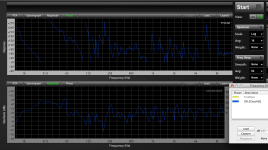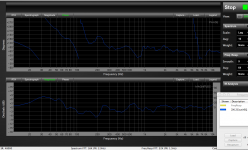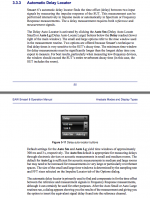By LF alignment, I mean time alignment of the top cabinets to the low cabinets within the crossover (overlap) region.What do you mean by "LF alignment"? How do you do that?
Generally that is done by first delaying the top cabinets the time required for the phase (and frequency response) to be smooth through the crossover region.
Different electrical slopes and frequencies as well as in band and out of band EQ may be needed, depending on the cabinet designs.
Mixing a sealed top and a sealed low may not require much DSP (other than knocking out the upper end of the lows so it does not sound like the vocalist is "lying down on the job") while aligning a sealed sub to a bass reflex (phase inversion) top or a sealed top to a horn load bass may require completely different delay, EQ and crossover slopes.
Most alignments I do are for PA, where DSP is pretty much a given, my home stereo sub alignment consisted of augmenting the too high too shallow slope crossover with an additional acoustical band pass on the dual 12 sub slot opening and some 1/3 octave EQ, using an Alesis DEQ830 inserted on the tape loop.
Art
Attachments
I believe that we can't localize sound sources below about 80Hz but I also believe that this is no longer true for frequencies above about 80Hz
......
Above 80Hz our hearing is able to extract localization cues from the sound field.
In my experience 80Hz might be a little high - I think the figure would be a little lower - perhaps 40-60Hz - in a well-designed room.
I designed my previous studio listening room with convex side walls (bowing inwards with a radius of 14') and a large wide bandwidth absorber involving most of the wall behind the speakers. Bass reproduction in that room was notable for the degree to which it remained consistent as you moved around the room. There was very little evident in the way of reinforcement or cancellation nodes. The R60 time sounded very short in the bass range, although I couldn't measure it. Bass stopped notably quickly. I ran dual subs located near the L/R speaker positions.
Under these circumstances I auditioned a monitor system comprising a pair of K+H 0300s and the K+H 0800 subwoofer, which has a high-passed L/R output. the slopes were 12dB/octave both ways, at 90Hz. I played some orchestral recordings of mine with which I am very familiar. With the single sub central I was able to hear the bass pulled so much toward the centre as for it to sound roughly halfway from where it should have been to the centre. To be more specific, from my listening position, instead of the basses sounding like they were at a 55º angle to the right, they sounded around 25º. This was unacceptable for my needs (I need to be able to place bass instruments correctly) though it might have been OK for many other forms of music.
The point is that, from this experience, I get the impression that a mono or non-direction-specific sub array would be acceptable only if it operated below about 40-60 Hz. And that's indoors, in a good acoustic.
Outdoors is another matter - I think the figure there may be lower, since bass "imaging" is even crisper.
... and that's why the Greek gods gave humankind blind and double-blind testing.
Crossing over at 12dB/8ave, you'd be lucky not to hear easily localizable upper frequency detritus coming from a sub crossing over at 30 Hz. Just a little bit of 120 Hz amp hum (on a high-efficiency driver) or the air turbulence moving through the magnet might be a tip off.
For a bunch of very welcome reasons such as low distortion products, folded (true) horn woofers hide their location better.
Many people (including me) have lived with woofers all but touching one of their ears but with sharp crossovers up to 140 Hz (1967-2007) and barely fussed about messed-up images with music sources.
So, if notions of localization are keeping a person from trying multiple subs, don't worry... so long as you use 24dB/8ave slopes.
If I recall correctly, Toole discusses how much a movie screen "captures" your precise sense of localization whatever the theatre sound is doing. As does looking at your woofer.
Ben
Crossing over at 12dB/8ave, you'd be lucky not to hear easily localizable upper frequency detritus coming from a sub crossing over at 30 Hz. Just a little bit of 120 Hz amp hum (on a high-efficiency driver) or the air turbulence moving through the magnet might be a tip off.
For a bunch of very welcome reasons such as low distortion products, folded (true) horn woofers hide their location better.
Many people (including me) have lived with woofers all but touching one of their ears but with sharp crossovers up to 140 Hz (1967-2007) and barely fussed about messed-up images with music sources.
So, if notions of localization are keeping a person from trying multiple subs, don't worry... so long as you use 24dB/8ave slopes.
If I recall correctly, Toole discusses how much a movie screen "captures" your precise sense of localization whatever the theatre sound is doing. As does looking at your woofer.
Ben
Last edited:
Member
Joined 2003
My process...
1. Measure the physical offset for a rough estimate.
2. Zoom amplitude on the HF/LF impulses to get a little closer. (sub impulses are a little tough)
3. Reverse phase null FR.
Began doing this about 10 years ago and, subjectively, the system sounded more "cohesive" with no noticeable seam between subs and the drivers above. It worked well so I redo it every time EQ or something significant changes.
Adds only a few minutes to system EQ.
1. Measure the physical offset for a rough estimate.
2. Zoom amplitude on the HF/LF impulses to get a little closer. (sub impulses are a little tough)
3. Reverse phase null FR.
Began doing this about 10 years ago and, subjectively, the system sounded more "cohesive" with no noticeable seam between subs and the drivers above. It worked well so I redo it every time EQ or something significant changes.
Adds only a few minutes to system EQ.
Markus, not sure if you are being funny, or asking a specific question.^
So how exactly do you do that "LF alignment"?
As I explained in #1661, the exact specifics of an alignment depend on a number of variables, but I use Smaart as the tool to measure those.
It has a delay finder, which is quite useful for "getting in to the ballpark" when doing alignments.
Markus, not sure if you are being funny, or asking a specific question.
As I explained in #1661, the exact specifics of an alignment depend on a number of variables, but I use Smaart as the tool to measure those.
It has a delay finder, which is quite useful for "getting in to the ballpark" when doing alignments.
Not trying to be funny but asking a specific question. By the way, Earl asked exactly the same question.
How does that "delay finder" in Smaart work? What are the variables you're measuring/taking into consideration?
Works pretty darn goodNot trying to be funny but asking a specific question. By the way, Earl asked exactly the same question.
How does that "delay finder" in Smaart work? What are the variables you're measuring/taking into consideration?
Variables to consider when time/phase aligning multiple enclosures are the acoustic crossovers of the speakers, delay (latency) in digital devices and the filters used, polarity, placement of the various cabinets, phase response of the various cabinets to be aligned, desired listening position, room size and shape.
Each different combination of room and hardware requires a bit different solution.
Attachments
I keep going back to Greisinger and his comments about "good bass" where the bass seems to be all around you. In what way is this "low frequency localization". I just don't get how "imaging" at low frequencies for music is in any way a significant issue. I have never consider it in the least and people rave about the bass in my rooms.
I keep going back to Greisinger and his comments about "good bass" where the bass seems to be all around you. In what way is this "low frequency localization".
Now you're arguing just like any other "Sounds good to me"-audiophoole. You want the room to add a specific quality ("bass seems to be all around you") regardless of the recording.
I just don't get how "imaging" at low frequencies for music is in any way a significant issue. I have never consider it in the least and people rave about the bass in my rooms.
...until they've heard my near field setup.
Works pretty darn good. The details are attached.
Variables to consider when time/phase aligning multiple enclosures are the acoustic crossovers of the speakers, delay (latency) in digital devices and the filters used, polarity, placement of the various cabinets, phase response of the various cabinets to be aligned, desired listening position, room size and shape.
Each different combination of room and hardware requires a bit different solution.
Sorry but that doesn't explain anything. You simply believe that Smaart delivers something useful without really knowing what that really is.
I keep going back to Greisinger and his comments about "good bass" where the bass seems to be all around you. In what way is this "low frequency localization". I just don't get how "imaging" at low frequencies for music is in any way a significant issue. I have never consider it in the least and people rave about the bass in my rooms.
I seem to remember Griesinger talking quite a bit about the overtone structure of LF notes.
In an acoustic performance bass sound might be all around you but the instrument certainly can be located by hearing, and same with a decent recording of such, because of that higher frequency content, especially the attack.
My thinking is that when the play back set up is good then of course the "LF sound" is locatable because sound of instruments' mid and HF content allows it.
Makes sense doesn't it? Guy plucks bass string and the HF comes to you pretty directly compared to LF. At least, that's what it seems like. But my bet is that our hearing has no problem attaching the bass notes' harmonic structure to the fundamental - cuz that's what a bass guitar or string bass or organ stop "sounds like". And bingo, you got location.
That can be "kinda fuzzy" when delays aren't quite aligned properly. With my old Klipschklone triamped system I could dial in a pizzicato bass section messing with the Beringer cross over.
Markus,Sorry but that doesn't explain anything.
Smaart, and other dual FFT measurement tools can provide useful information (arrival time, phase, and amplitude response) which can be used to set delay times, crossover slopes, frequencies and equalization to phase and time align loudspeaker systems through their various crossover points.
Sorry if my explanations are lacking the information you are looking for.
Are you looking for an explanation of some specific alignment?
Crossing over at 12dB/8ave, you'd be lucky not to hear easily localizable upper frequency detritus coming from a sub crossing over at 30 Hz. Just a little bit of 120 Hz amp hum (on a high-efficiency driver) or the air turbulence moving through the magnet might be a tip off.
So, if notions of localization are keeping a person from trying multiple subs, don't worry... so long as you use 24dB/8ave slopes.
Ben
For the record, I just read up on the sub I used in the example I gave (the K+H 0800 with the K+H 0300s) and see that the slopes were indeed fourth order, both low pass and high pass, not second order as I thought.
I need to hear whatever I can in the way of bass localization. The bass section in an orchestra does not have much in the way of mid and high frequency content - that's why their position moves so radically toward the center when the below-90Hz component was centralized.
When I mix my recordings, I think I owe it to the people who spend the time and big bucks setting up an accurate home playback system to create something that will sound right when that 1% plays it, and that entails wide bandwidth, tonally and spacially accurate, low distortion sound. I also operate on the presumption that this is the way home replay is going - in fits and starts - but ultimately in the direction of accuracy.
Markus,
Smaart, and other dual FFT measurement tools can provide useful information (arrival time, phase, and amplitude response) which can be used to set delay times, crossover slopes, frequencies and equalization to phase and time align loudspeaker systems through their various crossover points.
So what specific information do you use to "time-align"? What do you align to what? What specific parameters do you measure to determine proper "time-alignment"?
I need to hear whatever I can in the way of bass localization. The bass section in an orchestra does not have much in the way of mid and high frequency content - that's why their position moves so radically toward the center when the below-90Hz component was centralized.
"Bass section"? Do you mean the percussion?
You couldn't be more mistaken on that point - in fact, the struck instruments (except maybe that monster at the start of Strauss' Alzo Sprach...) have substantial and crucial content above 4000 Hz. Output in that tweeter range is more and more crucial to their timbre than the violins. My tweeter amp output power display lights up like a Christmas tree and so I ought to know what's going up in that range*... unless you feel my tweeter amp is biased and should be tested blind.
Doing the converse - running nothing but your woofer amp or just turning off your mid-range amp - is an interesting experiment.
Perhaps your mistaken belief that the "bass section" is coming out of your sub is the reason you feel you have so much localization ability. No doubt you do have good localization of those instruments. But it has nothing to do with the location of your sub.
Ben
*you'd be surprised how revealing it is to eyeball how much content our sources have - or lack - in that range and how deceptive is our own judgment.... speaking for myself here; some FM radio stations seem to have an MP3 in their playback chain (which means no high treble comes through) and have precious little upper range content, even if their live male announcers light up my tweeter amp on sibilants
Last edited:
When have you ever heard the percussion section being called the bass section? I mean the bass section - the basses on the far right (generally) of the orchestra. The contrabasses."Bass section"? Do you mean the percussion?
You couldn't be more mistaken on this point - I was talking about the percussion section - and I believe you brought up blind testing. And you are also wrong about the range of 4000Hz and above being crucial to the timbre of most percussion instruments, by the way.You couldn't be more mistaken on that point - in fact, the struck instruments have substantial and crucial content above 4000 Hz. Output in that tweeter range is more and more crucial to their timbre than the violins. My tweeter amp output power display lights up like a Christmas tree and so I ought to know what's going up in that range*... unless you feel my tweeter amp should be tested blind.
Oh yes it does. You may be surprised to learn I have thought this through very thoroughly indeed and have had "hi-fi aspirations" for at least as long as you. I make part of my living mastering others' recordings as well as my own and have spent many an hour improving my skills and my playback system. I also choose my words carefully.Perhaps your mistaken belief that the "bass section" is coming out of your sub is the reason you feel you have so much localization. No doubt you do have good localization of those instruments. But it has nothing to do with the location of your sub.
snip
I also choose my words carefully.
If you chose your words carefully, you would correctly say, "the basses or double basses... in the string section"
If we are now talking about the double basses, they have oodles of output in the middle range and that defines their localization, not the indistinct low grumbles in from the sub.
Lemme see what recordings do I have with double basses??? Goldmark's Rustic Wedding Symphony has that fabulous start. What's that Schubert quintet... The Trout. Or Marsalis' The Big Train. Gotta watch my tweeter amp display.
B.
Last edited:
I think a reason why people can localize their sub with a little high cross over is because of resonances and ringing from the room. It's so much easier to integrate a sub/midbass when that has been taken care of in my experience.
I think the opposite is true. My near field bass removes the room from the equation by a great deal. In such a situation all cues (even tactile cues) contribute to possible localization of a sub.
Adding lots of sources can create "phasiness" (above 80Hz) which tells our hearing "no useful localization cues other than you're within an enclosed space". While this may be pleasant for music reproduction, it's not what stereo is about. Lipshitz talks about this in his paper "Stereo Microphone Techniques: Are the Purists Wrong?". A highly recommended read.
- Home
- Loudspeakers
- Subwoofers
- Multiple Small Subs - Geddes Approach


